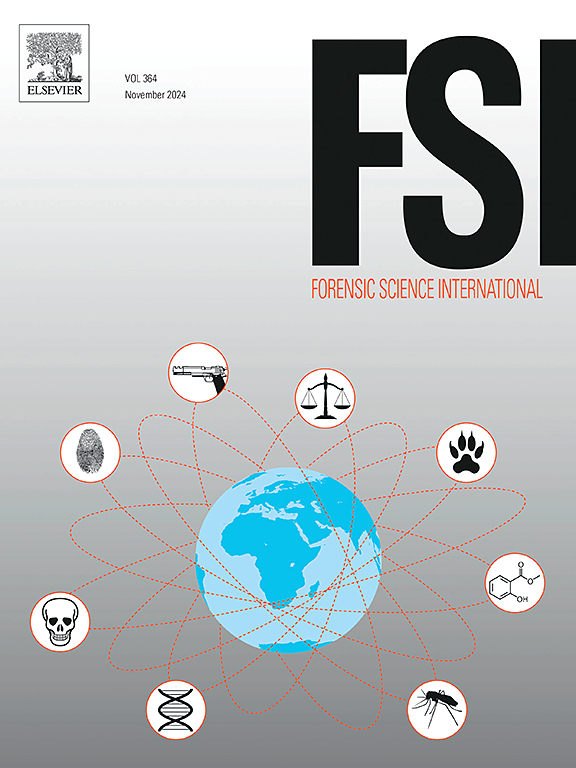基于昆虫发育的死后间隔估计的现场验证。第2部分:出现前间隔,专家证据选择和准确性基线数据。
IF 2.2
3区 医学
Q1 MEDICINE, LEGAL
引用次数: 0
摘要
这是现场实验的第二部分结果,旨在验证基于昆虫证据的PMI估计。首先,我们研究了用PAI补充年龄估计值后PMI的准确性提高。其次,我们比较了专家选择昆虫证据进行估计的各种方法对PMI的影响。第三,我们提供了使用不同方法、昆虫种类和生命阶段估算PMI准确性的基线数据。从暴露在森林栖息地的9具猪尸体中采集昆虫样本,每一到两个月采集一具猪尸体,使用标准技术从每具猪尸体中采集8-11个样本。研究发现,仅以昆虫年龄明显低估了昆虫种类和生命阶段的真实PMI。当年龄估计值与PAI相补充时,估计的PMI通常明显更接近真实PMI。在多个不同证据中平均PMI比使用单一证据产生更准确的估计。本研究中测试的最佳单证据方法,即使用最新定殖物种的最古老证据,产生的平均PMI误差约为22 %或25 %(取决于所使用的PAI类型)。对于最佳的多证据方法,即对早期定殖物种和晚期定殖物种的早期生命阶段的平均PMI,误差分别为13 %和16 %。使用30 %错误率得出的PMI范围在95% %的情况下涵盖了真实PMI,但仅适用于最佳多证据方法。这些结果表明,用于估算PMI(包括年龄和PAI估算)的复合昆虫学方法应用于模拟人类死亡病例时,具有令人满意的准确性。此外,目前的研究结果强调了PAI的重要性和使用多种昆虫证据来估计PMI的巨大好处。本文章由计算机程序翻译,如有差异,请以英文原文为准。
Field validation of post-mortem interval estimation based on insect development. Part 2: Pre-appearance interval, expert evidence selection and accuracy baseline data
This is the second part of the results from the field experiment aimed at validating PMI estimation based on insect evidence. First, we investigated the accuracy gains of PMI after supplementing age estimates with PAI. Second, we compared the impact on PMI of various ways, in which an expert selects insect evidence for the estimation. Third, we provided baseline data regarding the accuracy of PMI as estimated using different methods, insect species and life stages. Insects were sampled from nine pig carcasses exposed in a forest habitat, one carcass every one or two months, with 8–11 samples taken from each carcass using standard techniques. It was found that insect age alone clearly underestimates the true PMI across insect species and life stages. When age estimates were supplemented with PAI, the estimated PMI became generally significantly closer to the true PMI. Averaging PMI across multiple different pieces of evidence yielded more accurate estimates than using single evidence. The best single evidence method tested in this study, i.e. the use of the oldest evidence from the latest colonizing species, yielded the average PMI errors of about 22 % or 25 % (depending on the type of PAI used). For the best multiple evidence method, i.e. averaging PMI for late life stages of early colonizing species and early life stages of late colonizing species, these errors were about 13 % and 16 %. PMI ranges derived using 30 % error rate covered a true PMI in 95 % of cases but only for the best multiple evidence methods. These results demonstrate that the compound entomological method for estimating PMI (including age and PAI estimates), when applied to mock human death cases, is satisfactorily accurate. Moreover, the present findings highlight the importance of PAI and the great benefits of using multiple insect evidence to estimate PMI.
求助全文
通过发布文献求助,成功后即可免费获取论文全文。
去求助
来源期刊

Forensic science international
医学-医学:法
CiteScore
5.00
自引率
9.10%
发文量
285
审稿时长
49 days
期刊介绍:
Forensic Science International is the flagship journal in the prestigious Forensic Science International family, publishing the most innovative, cutting-edge, and influential contributions across the forensic sciences. Fields include: forensic pathology and histochemistry, chemistry, biochemistry and toxicology, biology, serology, odontology, psychiatry, anthropology, digital forensics, the physical sciences, firearms, and document examination, as well as investigations of value to public health in its broadest sense, and the important marginal area where science and medicine interact with the law.
The journal publishes:
Case Reports
Commentaries
Letters to the Editor
Original Research Papers (Regular Papers)
Rapid Communications
Review Articles
Technical Notes.
 求助内容:
求助内容: 应助结果提醒方式:
应助结果提醒方式:


